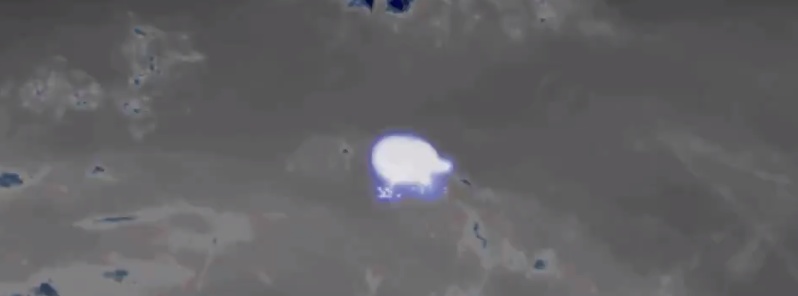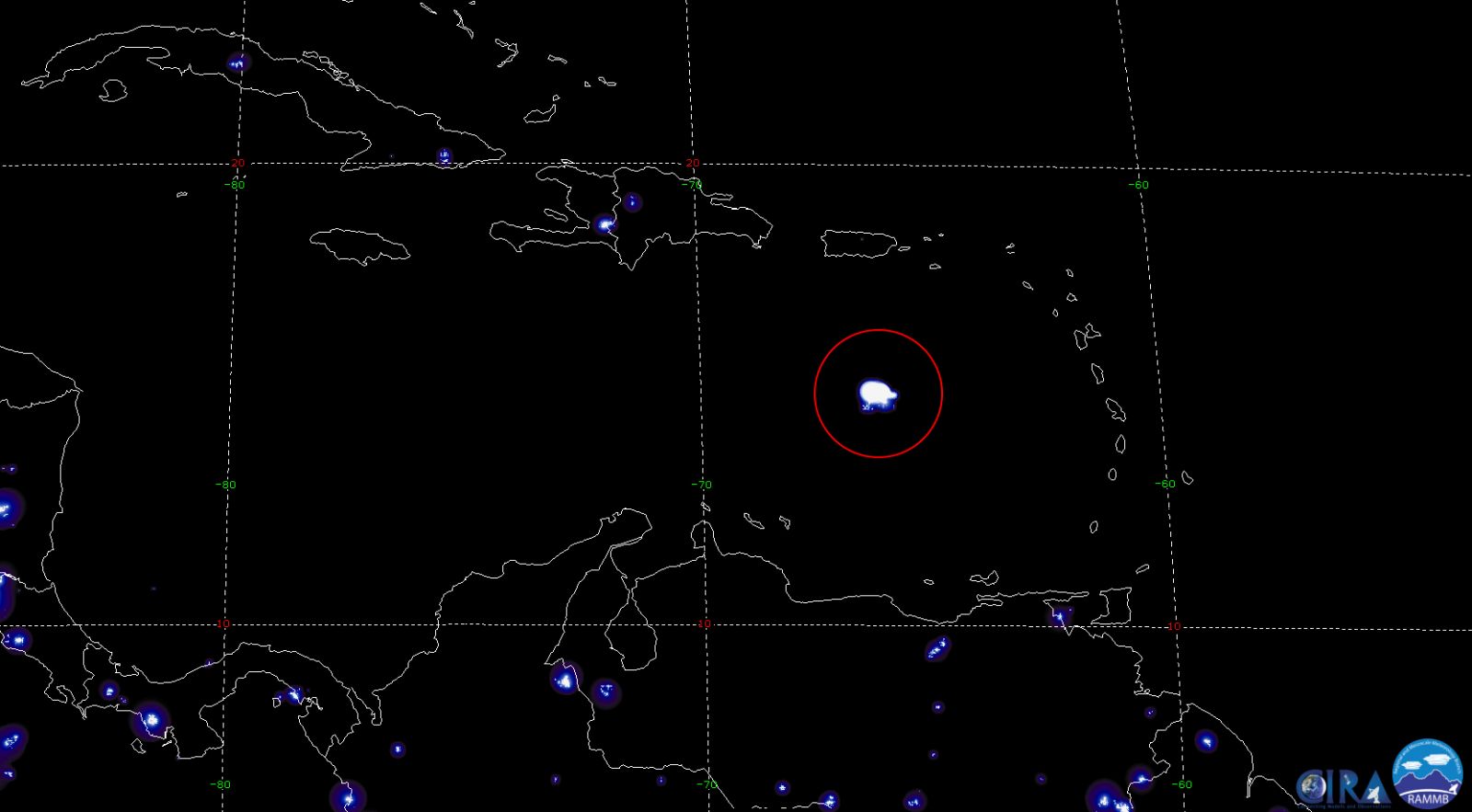Asteroid 2019 MO detected 12 hours before exploding over the Caribbean Sea

A small asteroid designated 2019 MO entered Earth's atmosphere over the Caribbean Sea and exploded south of Puerto Rico at 21:25 UTC on June 22, 2019, 12 hours after it was discovered.
The object was first detected just after 10:00 UTC (00:00 HST) on June 25 at ATLAS Mauna Loa, Hawaii when it was roughly 500 000 km (310 685 miles) from Earth or 1.3 times the distance to the Moon.

Asteroid 2019 MO estimated path by ATLAS Project

Image credit: NOAA/Goes-East, RAMMB/CIRA, IMO
This is only the fourth time an asteroid has been seen before it entered our atmosphere:
- 2008 TC3 – October 7: exploded at an estimated 37 kilometers (23 miles) above the Nubian Desert in Sudan 19 hours after discovery. Some 600 meteorites, weighing a total of 10.5 kilograms (23.1 lb), were recovered; many of these belonged to a rare type known as ureilites, which contain, among other minerals, nanodiamonds. The asteroid was approximately 4.1 m (13 feet) in diameter.
- 2014 AA – January 2, 2014: entered Earth's atmosphere 21 hours after discovery somewhere on an arc extending from Central America to East Africa; most likely just off the coast of West Africa. It was approximately 3 m (10 feet) in diameter.
- 2018 LA – June 2, 2018: entered atmosphere over Botswana at 16:44 UTC, 8 hours after it was discovered, producing an exceptionally bright fireball. Approximately 2.6 – 3.8 m (8.5 – 12.4 feet) in diameter.
2019 MO is believed to be a part of Alinda asteroids – a dynamical group of asteroids with a semi-major axis of about 2.5 AU and the orbital eccentricity approximately between 0.3 and 0.65.
"The fireball was detected with at least 3 Infrasound stations of the IMS (International Monitoring System) and from this data, we derived source energy of the entering asteroid of around 2.5 kt TNT. This would correspond to a size of about 4.5 m (14.7 feet) in diameter," IMO said.

"Airwaves recorded by Bermuda infrasound station 2 000 km (2 400 miles) North show periods which are consistent with 3 – 5 kT bolide from a small multi-meter sized NEA impact," a meteor scientist and planetary astronomer Peter Brown said.
Latest @UHIfA press release features our discovery of 2019MO. We located an incoming asteroid, with precoveries from @PanSTARRS2. This is the 4th asteroid to be discovered prior to impact! https://t.co/nY6Ot7WQZ9 pic.twitter.com/TA0BBgOoO6
— ATLAS Project (@fallingstarIfA) June 26, 2019
Good sized fireball off the South coast of Jamaica infrasonically on Jun 22 near 2130 UT. Airwaves recorded by Bermuda infrasound station 2000 km North show periods which are consistent with 3-5 kT bolide from a small multi-meter sized NEA impact. @IMOmeteors @amsmeteors pic.twitter.com/zNbHQLGijB
— Peter Brown (@pgbrown) June 24, 2019
Here is the event captured by the GLM. It shows that it was detected just south of Puerto Rico. here is the link to the RAMMB slider: https://t.co/4tYPyk6GmB pic.twitter.com/JeZV7XDKZF
— Frankie Lucena (@frankie57pr) June 25, 2019
Very nice catch!! Using available obs of A10eoM1 by F52 & T08, FINDORB finds an IMPACT on June 22, 2019 at 21:31:54UT at Lat +15.02 & Long W68.65 that seems remarkably close to data shared by @pgbrown & @frankie57pr pic.twitter.com/Av8JyorE2O
— Ernesto Guido (@comets77) June 25, 2019
Breakthrough: UH team successfully locates the incoming asteroid
The following information was provided in a press release issued June 25, 2019 by the Institute of Astronomy, University of Hawaii:
For the first time, astronomers at the University of Hawaiʻi have demonstrated that their ATLAS and Pan-STARRS survey telescopes can provide sufficient warning to move people away from the impact site of an incoming asteroid. They detected a small asteroid prior to its entering the Earth's atmosphere near Puerto Rico on the morning of June 22, 2019.
The 4-meter diameter asteroid, named 2019 MO, was observed four times in a span of 30 minutes by the ATLAS Maunaloa facility, just after midnight Hawaiʻi time on the morning of Saturday, June 22. At that time, the asteroid was only 500 000 km (310 685 miles) from Earth – or 1.3 times the distance to the Moon. These initial observations were assessed by the NASA Jet Propulsion Laboratory's (JPL) Scout impact analysis software, and the asteroid was given a modest impact rating of 2 (a rating of 4 is "likely"). However, JPL's Davide Farnocchia noted a possible match with an atmospheric infrasound detection near Puerto Rico about 12 hours later, and he asked if the community could search for additional observations.
Luckily, the Pan-STARRS 2 (PS2) telescope on Haleakalā was operating at the same time, and two hours prior to the ATLAS observations had imaged the part of the sky where 2019 MO should have been seen. The asteroid was located on a part of the PS2 camera that is not fully operational, but PS2 scientists Robert Weryk and Mark Huber, at the University of Hawai'i Institute for Astronomy (IfA) and Marco Micheli at the European Space Agency (ESA), were able to analyze these PS2 images and find the asteroid.
With these additional PS2 observations, the asteroid's entry path prediction improved significantly, and new calculations by the Scout software increased the impact rating to 4, or "likely." The improved orbit calculation also matched the infrasound detection with very high likelihood. The Nexrad weather radar in San Juan, Puerto Rico also detected 2019 MO as it burnt up in the atmosphere, and pinpointed the entry location over the ocean, about 380 km south of San Juan, closely corresponding to the infrasound location.
ATLAS consists of two telescopes, 100 miles apart, with one on Maunaloa on Hawaiʻi Island, and one on Haleakalā, Maui. They automatically scan the whole sky every two nights, looking in all directions and see asteroids before they can hit the Earth. It currently discovers about 100 asteroids with diameters bigger than 30m every year.
Scientists estimate that asteroid 2019 MO was much smaller, only about 4 meters (13 feet) across. An asteroid that small would likely burn up entirely as it enters Earth's atmosphere. The ATLAS telescopes can detect even such small objects about half a day before they arrive. It will find larger objects, like the one that exploded over Chelyabinsk, Russia in 2013, a few days before they impact. That asteroid was about 20 meters across, or the size of a house. For the first time in history, astronomers can provide sufficient warning to move people away from the impact site.
ATLAS and Pan-STARRS are funded by grants from the National Aeronautical and Space Administration's Near-Earth Object Observations program. The ATLAS program is described at their website.
Featured image credit: NOAA/GOES-East, CIRRA/RAMMB

Commenting rules and guidelines
We value the thoughts and opinions of our readers and welcome healthy discussions on our website. In order to maintain a respectful and positive community, we ask that all commenters follow these rules:
We reserve the right to remove any comments that violate these rules. By commenting on our website, you agree to abide by these guidelines. Thank you for helping to create a positive and welcoming environment for all.